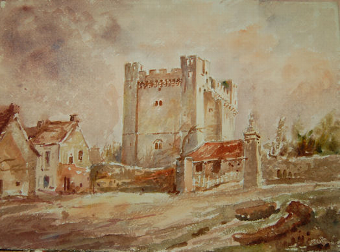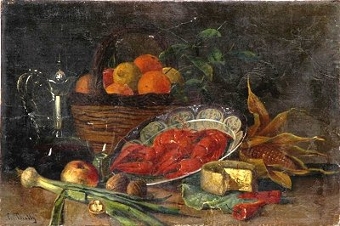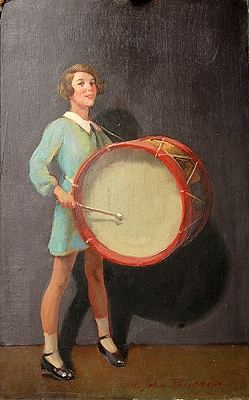43 x 32 in. frame
Giovanni Battista Moroni''s The Tailor - a 16th-century portrait of a man in cream doublet and red hose, looking steadily and sensitively out of the picture as he poses, scissors in hand, to cut a piece of black cloth - is one of the greatest paintings in the National Gallery, London, UK.
Giovanni Battista Moroni (c. 1520/24[1] ? February 5, 1578) was an Italian painter of the mannerist period. He is also called Giambattista Moroni. Known for his starkly realistic depictions, he is considered one of the great portrait painters of the sixteenth century Italy.
The son of an architect, Andrea Moroni, he trained under Alessandro Bonvicino "Il Moretto" in Brescia, where he was the main studio assistant in the 1540s, and worked in Trent, Bergamo and his home town of Albino, near Bergamo, where he was born and died. His two short periods in Trento coincided with the first two sessions of the Council of Trent, 1546?48 and 1551?53. On both occasions Moroni painted a number of religious works (including the altarpiece of the Doctors of the Church for the church of Santa Maria Maggiore, Bergamo) as well as the series of portraits for which he is remembered.
During his stay in Trent he also made contact with Titian and the Count-Bishop, Cristoforo Madruzzo, whose own portrait is by Titian but for whom Moroni painted portraits of his sons. There were nineteenth-century claims that he was trained by Titian at Trento; however, it is improbable he ever ventured to the Venetian''s studio for long, if at all. Moroni''s period as the fashionable portraitist of Bergamo, nowhere documented but in the inscribed dates of his portraits, is unexpectedly condensed, spanning only the years ca. 1557?62, after which Bergamo was convulsed in internecine strife and Moroni retired permanently to Albino, (Rossi, Gregori et al.) where, in his provincial isolation, he was entirely overlooked by Giorgio Vasari. His output at Bergamo, informed in part by study of the realism of Savoldo, produced in the few years a long series of portraits that, while not quite heroic, are full of dignified humanity and grounded in everyday life. The subjects are not drawn exclusively from the Bergamasque aristocracy, but from the newly self-aware class of scholars and professionals and exemplary government bureaucrats, with a few soldiers, presented in detached and wary attitudes with Moroni''s meticulous passages of still life and closer attention to textiles and clothing than to psychological penetration.
Don Gabriel de la Cueva, 1560. His output of religious paintings, destined for a less sophisticated audience in the local sub-Alpine valleys, was smaller and less successful: "the exact truth of parts nowhere added up, in his altar pictures, even to the semblance of credibility," Freedberg has observed of their diagrammatic schemes borrowed from Moretto and Savoldo and others.[3] for example, he painted a Last Supper for the parish at Romano in Lombardy; Coronation of the Virgin in Sant''Alessandro della Croce, Bergamo; also for the cathedral of Verona, SS Peter and Paul, and in the Brera Academy of Milan, the Assumption of the Virgin. Moroni was engaged upon a Last Judgment in the church of Gorlago, when he died. Overall, his style in these paintings shows influences of his master, Lorenzo Lotto, and Girolamo Savoldo. Giovanni Paolo Cavagna was an undistinguished pupil of Moroni; however, it is said that in following generations, his insightful portraiture influenced Fra'' Galgario and Pietro Longhi.
S.J. Freedberg notes that while his religious canvases are "archaic", recalling the additive compositions of the late Quattrocento and show stilted unemotive saints, his portraits are remarkable for their sophisticated psychological insight, dignified air, fluent control and exquisite silvery tonality. Patrons for religious art were not interested in an individualized, expressive "Madonna"; they desired numinous archetypal saints. On the other hand, patrons were interested in the animated portraiture.
Moroni is the kind of obscure genius it''s a delight to discover. He was born in the early 1520s in Albino, a small town near the city of Bergamo, close to the Italian Alps; he worked all his life in the area. Italy in the Renaissance was divided into a patchwork of city-states, and just because you stayed in your own city didn''t mean you were limited. Moroni''s portraits are stupendous evidence of how Renaissance ideas spread far beyond Florence. A young man poses above an inscription from Virgil''s Aeneid, in Latin; cavaliers stand in front of ruined columns and marble walls, sweetly melancholic memories of ancient Rome. The elite of Bergamo were privileged to have a local genius who, instead of heading off for Venice where he would have had to compete with Titian, portrayed them. The Renaissance props are the least of it.
Most of all, Moroni is an incredible colourist - a fact you can miss, as his particular scintillation lies in arrangements of black and grey. His Portrait of a Gentleman with his Helmet on a Column Shaft has just a patch of slightly cloudy sky visible: nearly all the background is cut off by a classical ruin. Grey stone, you might think, is a less-than-sexy background for a man in black clothes, with his chain-mail armour sleeves and steel helmet adding yet more varieties of monochrome, but it''s magical, luxurious. Black clothes have been high fashion since the 15th century. The greys and silvers here are modulated by brown weed bursting out of the wall, the rich blue veining of a column, the glint of light on metal - and, of course, those red beards.
Moroni epitomises what a sophisticated thing the portrait had become in Italy by this time. Capturing someone''s look was easy; artists could now play complex, teasing games of identity. Moroni''s faces are ordinary and recognisable - a red nose, hooded eyelids, or the taut nervousness of his Bust Portrait of a Young Man with an Inscription make them seem like people you see in the street - yet in each painting a story is alluded to, without being explained. Who is the lover the young man reassures of his loyalty "while there''s breath in my body"? Why does a knight posing with his jousting helmet wear a leg brace?
The Tailor takes this late-Renaissance blend of reality and poetry in a revolutionary new direction. No one had painted an ordinary artisan like this before. Yet this painting is a tease, a game. Its purpose is to confuse categories of class and power, and the question of who has the right to be portrayed as a complex individual.
It''s not the fact that Moroni shows a tailor that''s exceptional, but the fact that he gives him the same nobility of pose and countenance as his aristocratic clients. The Tailor holds scissors in the same way Moroni''s nobles display swords. The fact that he is wearing a sword belt should not be taken literally - it may be a joke: the belt is empty, because the scissors are his sword. They look dangerous. He wears a red codpiece between his bulging pantaloons. I''m a tailor, he''s saying, but I''m a real man. There is steel in his eye, and a challenge.
Is this literally a revolutionary picture, in which a man outside the ruling class stands up for his dignity with an anger that anticipates the French Revolution, two centuries later? Why would Moroni paint that?
It is a revolutionary statement, but most of all it is art that is rising up. Bergamo wasn''t Venice, Florence or Rome. Artists in these cities, for the first time in the history of the world, started in the 16th century to become stars. Traditionally, artists were humble artisans who, like tailors, were apprenticed in their childhood to a master. To become a "master" in turn was like being a master tailor, authorised to have your own workshop. Moroni may or may not be depicting a real tailor, but I believe one thing is certain: he is also portraying himself.
The tailor is using his scissors to cut a piece of black cloth. Look at Moroni''s portraits of gentlemen; they are all wearing black. Stuck in Bergamo, where modern ideas about the artist as a creative god had not yet reached his patrons, Moroni does the same job as a tailor; he dresses up his fine gentlemen, fashions their dignity. In this painting he rebels, and portrays the artisan as an artist, the artist as artisan.
Earlier in the century, artists such as Michelangelo and Titian had claimed to be equal with princes. Moroni is one of the first in a new wave of Italian artists who identify instead with the workers. In Bologna in the 1580s, Annibale Carracci painted The Butcher''s Shop, which gives manual work the dignity of sculpture, reversing the ancient prejudice that accused sculptors of being manual workers. The sculptor Bernini would extend this respect for the people when he carved a bust of his working-class lover. Yet what Moroni most glaringly anticipates is more dangerous. Who does the Tailor remind you of, as he looks out of the painting with that raw male frankness? Surely Caravaggio''s market fruit-sellers. Caravaggio, too, came from northern Italy and, like Moroni, mixed Renaissance sensuality with vernacular realism. Moroni anticipated Caravaggio''s revolution, and deserves to be as famous as he is.
Antiques.co.uk Ref: A87WG3HF
- Materials:
- Oil on Board
- Width (cm):
- 101.60 x 76.20 cm (40 x 30 ins)














